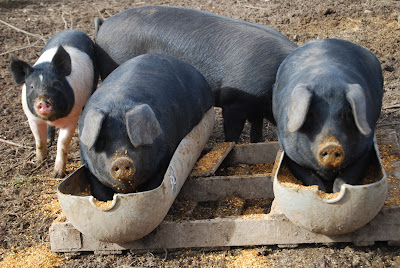Raising children on a farm has been done for several thousand years. We have been doing it for about five. We don't pretend to be experts. We constantly wonder whether we're doing it right.
Our son has always been rough, he runs fast, climbs high (he is the inspiration for our farm name, Climbing Tree Farm), a game of tag for him is a contact sport. And, he has been coming to the slaughter house with us since he was a toddler. We hoped it wouldn't encourage him to be more rough or callous him to the idea of death. It terrified us when he was three and announced that he wanted to be a "killer"when he grew up. (Which turned out to be his name for a butcher, and made sense because he loved going to visit the butchers twelve children). Mostly he has seemed to understand that our animals have the job of making meat and that, while we treat them well, they are not pets.
When an animal is born here, or when we buy one in, we make it clear immediately to our son which animals will be staying on the farm indefinitely, and who will be used for meat. As a three year old he could tell you: "We keep the girl lambs, but not the boys. The red chickens will lay eggs and we can keep them for two years. The white chickens are for meat and we don't keep them."
Pigs, while we love them, and scratch behind their ears, are never kept as pets.
Until last winter we never formally named a pig (though some have gotten names like Chubby, Big Mama, or Spot to differentiate in the field). That is, until our son met Funny Eyes. A fuzzy runt, named for her beautiful light turquoise eyes with long dark lashes, our son was immediately smitten. (Our pigs usually have deep brown eyes). He could pick his special pig friend out from fifty yards, and often visited with her, despite her shyness.
Because Funny Eyes was the smallest she stayed on the farm much longer than her litter mates. For the past eight months we've been reminding our son that his pretty-eyed friend would not be able to stay forever. Last week Funny Eyes reached her optimal size and was loaded for slaughter. Our son was there when she was loaded in the trailer, but couldn't look her in her liquid blue eyes to say
goodbye. All he could do was sob.
Later, when Funny Eyes had gone, he cried some more, and then
brightened. "Mama" he asked "can we get Funny Eye's heart back{from the butcher}?" I didn't know where he was going with this, but agreed and asked why."Because, mama, the heart is where all the love is. I want to eat her heart to keep her love." And, so, with this gruesome request, it has become clear: our son is a lover, not a "killer." While initially it creeped me out that our son wants to eat his beloved pig-friend's heart, it made me enormously proud that he thought of a way to transcend the death of his buddy and store up her love. (Not to mention his culinary adventurousness). It also reminds me of the adage "you are what you eat," and makes me thankful that we have the opportunity to feed our children and our community pigs who have been adored, scratched behind the ears, and who have love in their hearts. One question remains, what's the most delicious way to serve pork heart?
 |
| Young Funny Eyes....not sure why she's so dirty in this picture, she must have been having fun! |











